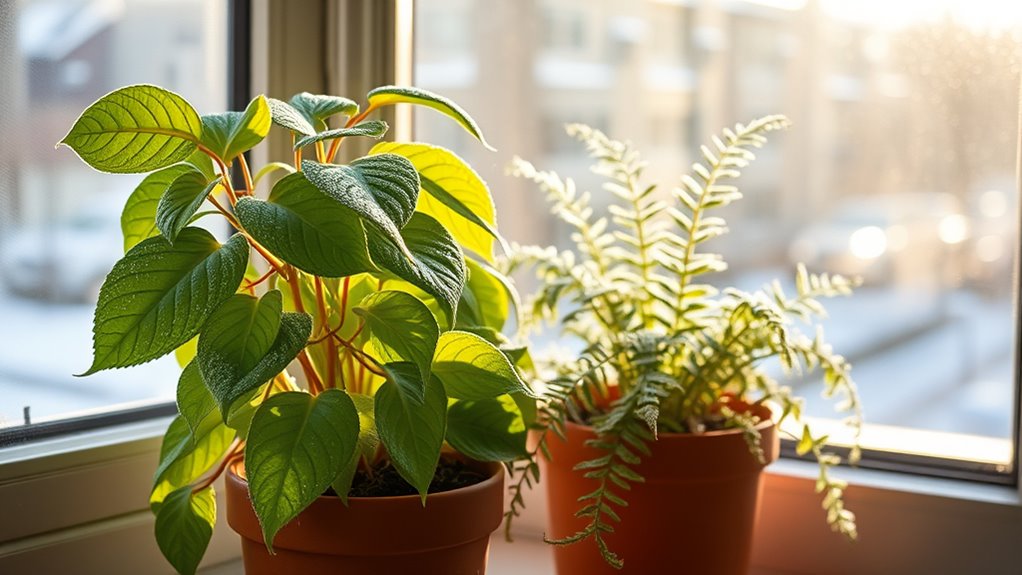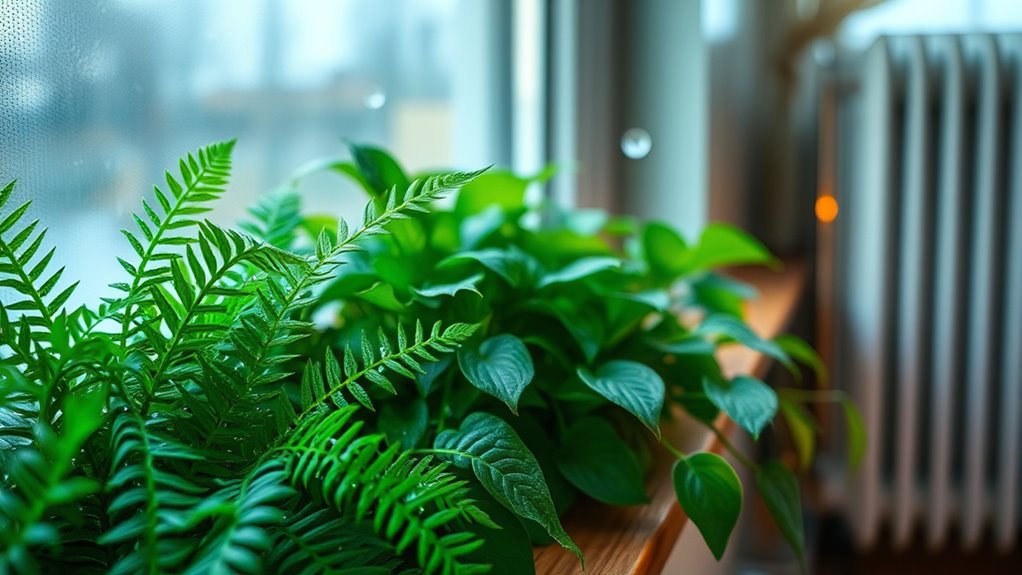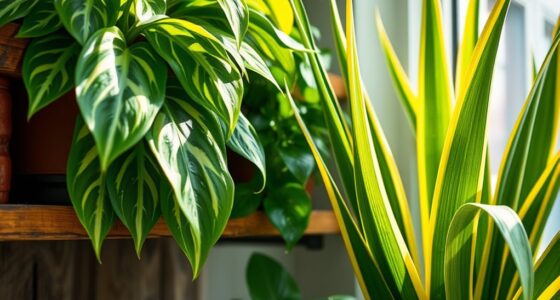During winter, you should water your houseplants less frequently since soil stays moist longer and overwatering can cause root rot. Place them near south or west-facing windows for plenty of indirect light, or use grow lights if natural light is limited. Keep the temperature steady between 65-75°F and boost humidity with a water tray or humidifier. Monitoring soil moisture and adjusting care maintains your plants healthy, and you’ll find more tips to guarantee their well-being as you continue caring.
Key Takeaways
- Water houseplants less frequently, checking soil moisture before watering to prevent overwatering and root rot.
- Place plants near south or west windows for adequate indirect light, supplement with grow lights if needed.
- Maintain stable indoor temperatures between 65-75°F and avoid drafts or proximity to cold windows.
- Increase humidity using humidifiers or water trays to prevent leaf browning and stress.
- Use pots with drainage holes and monitor soil moisture regularly to ensure proper watering and soil health.

Are your houseplants ready to brave the winter months? As the days grow shorter and natural light dims, it’s essential to adjust your care routine to keep your plants healthy and thriving. One of the first things to focus on is your watering habits. During winter, plants typically require less water because their growth slows down and the soil stays moist longer. Overwatering is a common mistake that can lead to root rot and other issues, so check your plants’ soil before watering. Stick your finger about an inch into the soil; if it feels dry, it’s time to water, but if it still feels moist, wait a few more days. Remember, the goal is to keep the soil lightly moist, not soaked. Also, consider reducing the frequency of watering compared to warmer months, but don’t let the soil completely dry out. Using pots with drainage holes helps prevent excess water from sitting at the bottom, further protecting your plants from overwatering. Understanding plant watering needs is crucial for maintaining healthy houseplants during cold months.
Lighting adjustments are equally critical as natural daylight diminishes. Most houseplants thrive with bright, indirect light, but winter sunlight is often weaker and less consistent. To compensate, place your plants closer to windows that face south or west, where they can receive the most light during the day. If natural light is limited, supplement with grow lights to ensure your plants still get enough energy. Rotate your plants weekly to promote even growth, since they tend to lean toward the light source. Keep an eye out for signs of inadequate lighting, like stretching or pale leaves, and make adjustments promptly. Also, avoid placing plants near drafts or heating vents, as fluctuating temperatures and dry air can stress them out.
Temperature stability is another factor that influences how you care for your houseplants in winter. Most prefer temperatures between 65-75°F, so keep them away from cold windows or exterior walls where drafts might occur. Using a humidifier or placing a tray of water nearby can help add moisture to the air, especially if your home tends to be dry due to heating systems. Maintaining proper humidity levels prevents leaf edges from browning and keeps your plants comfortable.
Frequently Asked Questions
How Can I Prevent Pests During Winter?
To prevent pests during winter, you should regularly inspect your houseplants for signs of pests and remove any affected leaves. Keep your plants healthy with proper watering and avoid overwatering, which attracts pests. Use natural pest prevention methods like neem oil or insecticidal soap if needed. Maintaining good airflow and reducing excess humidity also helps prevent winter pests from settling in, ensuring your houseplants stay healthy all season.
Should I Rotate My Houseplants for Even Light?
Yes, you should rotate your houseplants regularly to guarantee even light distribution. By adjusting their plant positioning, you prevent uneven growth and keep all parts receiving adequate light. Turn your plants every week or so, especially if they’re near windows, to promote balanced growth. This simple step helps your plants thrive during winter, maintaining healthy foliage and preventing legginess caused by light imbalance.
How Do I Increase Humidity Without Misting?
To increase humidity without misting, you can use humidity control methods like placing a tray of water with pebbles beneath your plants, ensuring the pots sit above the water. This creates a humid microenvironment, helping with plant hydration. You might also group plants together or use a humidifier nearby. These techniques boost humidity naturally, supporting your houseplants’ health during winter.
When Is the Best Time to Fertilize in Winter?
You should schedule your winter feeding around once a month, as houseplants need less fertilizer during this time. Avoid fertilizing when your plants are dormant or showing no growth, typically in the coldest months. Focus on proper fertilizer scheduling to make certain your plants get nutrients without overdoing it. This approach helps maintain their health through winter while preventing root burn or nutrient buildup.
Can I Use Grow Lights to Supplement Natural Light?
Yes, you can use grow lights to supplement natural light and give your houseplants a boost during winter. Artificial lighting with the right light spectrum guarantees plants receive the necessary wavelengths for photosynthesis, especially when natural light is scarce. By choosing grow lights wisely, you’ll create a perfect environment that keeps your plants healthy and thriving, even when the days are short and gloomy outside.
Conclusion
As winter’s chill settles in, think of your houseplants as delicate winter blooms needing your warm embrace. With a little extra care, you’ll nurture their roots like hidden treasures beneath frosty blankets. Keep them cozy, and they’ll thrive like vibrant gems glowing through the cold. Remember, your attention turns your indoor jungle into a resilient oasis—where life whispers hope even in the coldest months. Embrace the challenge, and watch your greenery flourish against winter’s icy backdrop.









